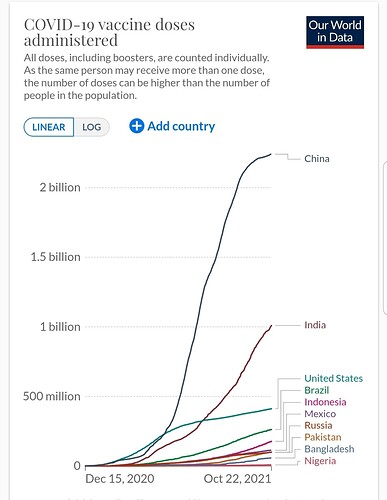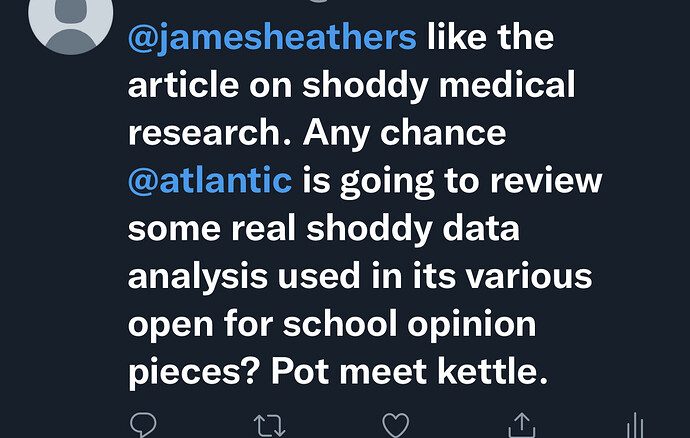I cant find this chart by vaccine type or brand, but we can probably make some assumptions.
https://www.google.com/amp/s/amp.theatlantic.com/amp/article/620473/
Good piece on how the pandemic has exposed the shoddy state of biomedical research.
i think fraud and ignorance in academic research is probably not a “new” problem, since even modern privilege and incentives for scientists are rooted in a system that’s likely at least 100 years old. meta scientific research is certainly warranted, and i’m encountering a lot of serious content about it. i hope it develops.
but i also think it’s not as dire as the article makes it sound. academia is not meant to be an efficient institution, and that particular inefficiency isn’t even a top priority when roughly the same group of students and doctors are in charge of actually treating patients. it would be silly to expect academic output of a small group of people to be anything other than an imperfect result. it takes orders of magnitude more effort to achieve something truly remarkable, like mRNA vaccines or large colliders.
it is worrisome that’s it’s all volunteers right now. NSF or a coalition of top universities should probably finance a broad and diverse effort to prioritize and review recent work.
LOL US healthcare
I think I mentioned that my daughter got tested for COVID the other week. Got the bill a couple days ago: $600 for a telehealth appointment, one flu test and one COVID test.
I have a high-deductible insurance plan, so not sure how much insurance would pick up on other types of plans. But still seems pretty ridiculous.
i should also say that a lifetime ago in grad school, my prof gave me two papers to review for a panel she was hosting during some conference or publication. i don’t remember if i got to both papers or just one. they were utterly unimpressive and unimportant results where someone tried an algorithm on a dataset and concluded something very weak, because a stronger hypothesis was inconclusive. the algorithms weren’t original, didn’t apply to the real world, and both were forgotten quite fast. the datasets turned out to be both shoddy and the best available to the researchers at the time.
i tried to give them an honest review, starting with the “i don’t believe you” attitude. but even that was unnecessary. the whole thing was an exercise to force two grad students at one school to write down what they had lazily worked on, and for the preprint to make it to another school to force another student to do some work instead of delaying dropping out (or graduation) out of laziness. but even without knowing any characters, everyone in the story eventually worked out fine. the system worked as intended.
The pandemic did not expose this. It’s been there for a long time. The real scandal about ivermectin remains the people dying
Since even with a high deductible plan you only pay the insurance company’s allowable rate, I’m surprised that you would have to pay more than $200 for a telehealth appointment.
The telehealth line item was around $200, so it’s the tests that were really expensive.
Huh. Is the Atlantic reviewing its writers and op-Ed’s that were wholly based on this shoddy science and data analysis?
Also, the scientific response to COVID has been unparalleled in history for how fast and effective its been. We had a vaccine in testing a few months after the initial outbreak with a proven effective vaccine about 12 months after the initial outbreak, plus several effective therapeutics to a novel virus. But ok Atlantic.
Where did the image you posted come from? Doesn’t appear to come from the document you linked to.
paper literally makes the case it’s not vaccine waning in the abstract churchill. You should read the things you cite.
Patterns of breakthrough infection over time were consistent by age, despite rolling vaccine eligibility, implicating the Delta variant as the primary determinant of infection.
This was a big red flag for me, as we know the vaccine is effective against delta at least in the beginning, and we should expect to see a dose/time relationship. That means this paper is a big outlier.
And behold:
https://twitter.com/AviBittMD/status/1452324100140044295
That’s a big mistake. Come on buddy.
Posting the results of a VA study is antivax?
Findings support continued efforts to increase vaccination and an immediate, national return to additional layers of protection against infection
I know we’ve all gotta dunk on Churchill, and I know you specifically hate reading anything, but from page 7, first paragraph of “discussion”:
Our analysis of infection by vaccine type, including the Pfizer-BioNTech, Moderna, and Janssen vaccines, suggests waning vaccine protection against infection over time, particularly for the Janssen vaccine. These results demonstrate an urgent need to reinstate multiple layers of protection against infection, such as masking and physical distancing, while also bolstering current efforts to increase vaccination.
What’s up Jman?
I thought the image was easier reading than this from the report
Specifically, in March, protection against infection was: 88% (95% CI, 87% to 89%) for Janssen; 92% (95% CI, 92% to 93%) for Moderna; and 91% (95% CI, 91% to 92%) for Pfizer-BioNTech.
By August, protection against infection had declined to: 3% (95% CI, -7% to 12%) for Janssen; 64% (95% CI, 62%-66%) for Moderna; and 50% (95% CI, 47% to 52%) for Pfizer-BioNTech.
Seems the image creator erred on the positive side for March stats and was bang on for the August stats (if it were an anti-vaxx site we’d see J&J at -7%)
It’s whatever you want it to be when you don’t like somebody!

